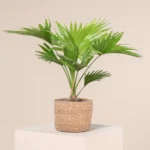Discovering the Elegance of String of Hearts: Comprehensive Care, Propagation, and Decorating Tips
Introduction
The String of Hearts (Ceropegia woodii), also known as the Rosary Vine or Chain of Hearts, is a charming trailing plant that captivates with its delicate, heart-shaped leaves and elegant cascading vines. Native to South Africa, this plant thrives in a variety of conditions, making it a popular choice for both indoor and outdoor gardening. With its unique appearance and minimal care requirements, the String of Hearts is perfect for adding a touch of green to any space. This comprehensive guide offers detailed insights into the care, propagation, and creative uses of the String of Hearts, providing valuable information for both novice and experienced plant enthusiasts.
Quick Facts
| Fact | Details |
|---|---|
| Scientific Name | Ceropegia woodii |
| Common Names | String of Hearts, Rosary Vine, Chain of Hearts |
| Native Regions | South Africa |
| Optimal Humidity | 40-60% |
| Optimal Temperature | 60-80°F (15-27°C) |
| Soil Type | Well-draining, sandy or cactus mix |
| Watering Needs | Moderate, allow soil to dry between waterings |

Physical Characteristics
The String of Hearts is a perennial succulent with long, trailing vines that can grow up to 3-4 feet in length. Its small, heart-shaped leaves are typically green with silver variegation and purple undersides, adding to its visual appeal. The plant also produces small, tubular, pale magenta flowers, although they are less prominent than its distinctive foliage.
Nutrition, Foods to Avoid
String of Hearts requires minimal fertilization. During the growing season (spring and summer), a balanced, diluted liquid fertilizer can be applied once a month to support healthy growth. Avoid over-fertilization, as it can lead to leggy growth and reduced overall plant health.
Health and Diseases
String of Hearts is generally robust but can suffer from root rot if overwatered or planted in poorly draining soil. Common pests include aphids, spider mites, and mealybugs, which can be managed with insecticidal soap or neem oil. Maintaining proper watering practices and ensuring good air circulation can help prevent these issues.

Propagation Methods
Propagation of String of Hearts is straightforward and can be achieved through:
- Stem Cuttings: Cuttings taken from the vines can be rooted in water or directly in soil. Ensure each cutting has at least a few leaves.
- Tubers: Small tubers that form along the vines can be planted to grow new plants.
- Leaf Cuttings: Leaves placed on moist soil can also produce new plants, though this method is slower.
Pricing Information
| Type | Average Price |
|---|---|
| Small potted plant | $10 – $15 |
| Medium potted plant | $15 – $25 |
| Large potted plant | $25 – $40 |

Factors Affecting Price
- Plant Size and Age: Larger and more mature plants typically command higher prices.
- Variegation: Plants with more pronounced or unique variegation can be more expensive.
- Health and Condition: Plants in optimal health with vibrant foliage are more valuable.
Price in Different Regions
| Region | Average Price |
|---|---|
| USA | $15 |
| Europe | €12 |
| Asia | ¥1000 |
FAQs
Q: How often should I water my String of Hearts?
A: Water when the top inch of soil is dry, typically every 1-2 weeks. Reduce watering in the winter.
Q: Can String of Hearts be grown indoors?
A: Yes, it thrives indoors with bright, indirect light and moderate watering.
Q: Is String of Hearts safe for pets?
A: Yes, String of Hearts is non-toxic to pets.

Related Plants
Other trailing plants like the String of Pearls (Senecio rowleyanus) and the Chain of Hearts (Ceropegia linearis) share similar care requirements and can be grown alongside String of Hearts.
References
Categories
Succulents, Trailing Plants, Indoor Gardening, Low-Maintenance Plants, Decorative Foliage
This comprehensive guide provides all the essential information needed to cultivate and care for String of Hearts successfully. Whether for personal enjoyment or as part of a larger plant collection, this charming and delicate plant offers a unique and rewarding gardening experience.
Views: 9









